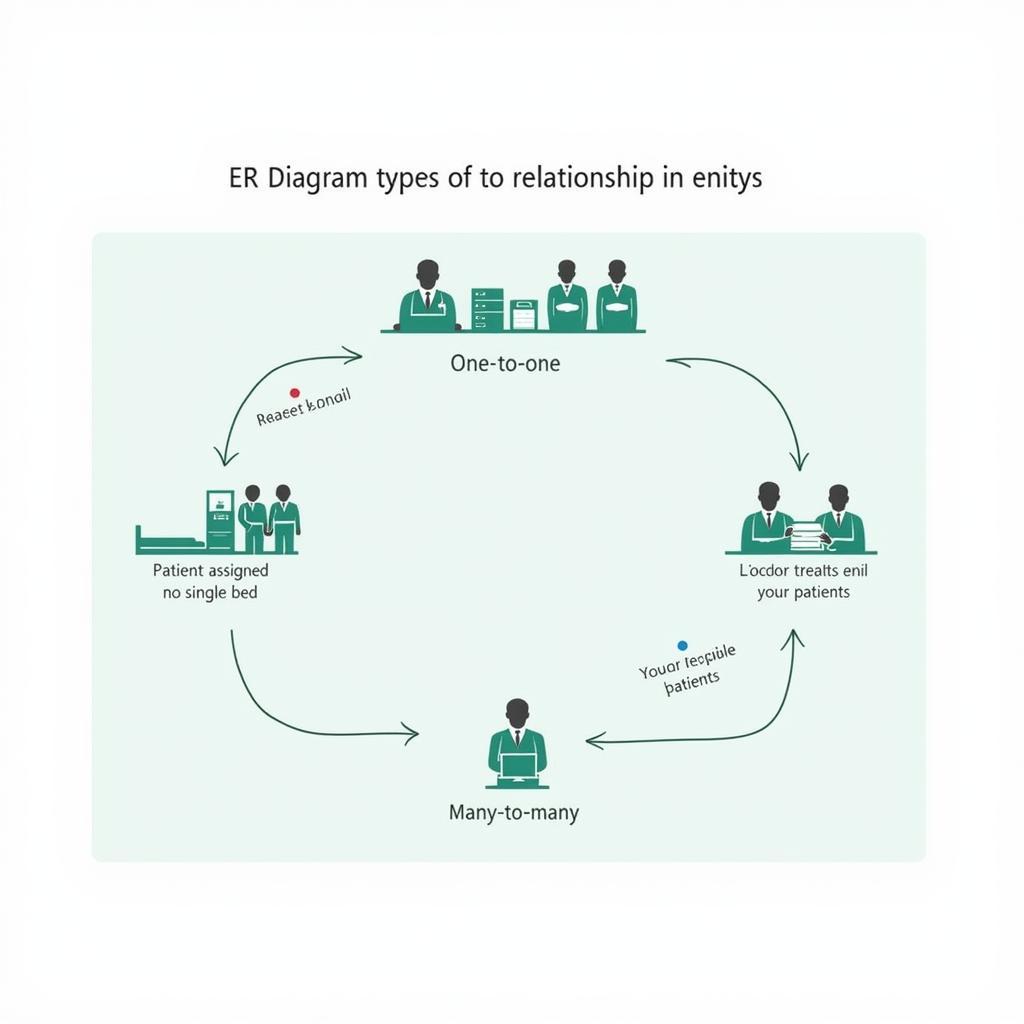An Er Diagram Hospital, also known as an entity-relationship diagram for a hospital, is a visual representation of the hospital’s database structure. It maps out the various entities, their attributes, and the relationships between them, providing a blueprint for how data is organized and interconnected within the hospital management system. Understanding this diagram is essential for effective hospital management, data analysis, and system development. Let’s dive deeper into the complexities of this crucial tool.
Decoding the ER Diagram for Hospital Management
ER diagrams are fundamental to hospital database design. They offer a clear, concise way to visualize the structure and interrelationships of data within a complex system like a hospital. These diagrams are not merely static representations; they serve as dynamic blueprints for developers, administrators, and analysts, facilitating efficient communication and informed decision-making. By understanding the ER diagram, stakeholders can gain valuable insights into data flow, system functionalities, and potential areas for improvement. They serve as a bridge between technical and non-technical personnel, fostering a shared understanding of the hospital’s data ecosystem.
Key Components of an ER Diagram Hospital
Entities, Attributes, and Relationships
The core components of an ER diagram are entities, attributes, and relationships. Entities represent real-world objects or concepts within the hospital system, such as patients, doctors, or departments. Attributes describe specific characteristics of these entities, like a patient’s name, ID, or medical history. Relationships define how different entities interact with one another, for instance, a doctor treats a patient, or a patient stays in a room. Visualizing these components provides a structured overview of the hospital’s data architecture.
Types of Relationships in an ER Diagram for Hospital Management System
 ER Diagram Showing Hospital Management Relationships
ER Diagram Showing Hospital Management Relationships
Relationships within an er diagram for hospital management system can be one-to-one, one-to-many, or many-to-many. A one-to-one relationship exists when one entity is associated with only one other entity, for example, a patient assigned to a single bed. A one-to-many relationship occurs when one entity can be associated with multiple instances of another entity, such as a doctor treating multiple patients. A many-to-many relationship exists when multiple instances of one entity can be associated with multiple instances of another entity, like patients receiving multiple treatments from different doctors. Understanding these relationship types is crucial for designing a robust and efficient hospital management system.
Benefits of Using an ER Diagram in Hospital Management
An hospital management system e-r diagram provides several crucial benefits. It simplifies complex data structures, making it easier to understand the data flow and interactions within the hospital system. This clear visualization improves communication among stakeholders, from IT professionals to medical staff, ensuring everyone is on the same page regarding data management. Furthermore, the ER diagram helps identify potential redundancies and inconsistencies, contributing to a more efficient and streamlined database design.
How ER Diagrams Enhance Hospital Operations
“ER diagrams are not just technical tools,” says Dr. Maria Sanchez, a leading healthcare IT consultant. “They are instrumental in optimizing hospital operations by providing a clear framework for data management and analysis.” They facilitate efficient resource allocation, streamline patient admissions, and support informed decision-making based on reliable data insights.
Integrating ER Diagrams with Hospital Management Systems
Integrating ER diagrams with hospital management system modules is essential for effective data management. The diagram serves as a blueprint for the database structure, ensuring data integrity and consistency across different modules. This integration simplifies data retrieval and analysis, providing valuable insights for improved patient care and operational efficiency. It also helps in troubleshooting and identifying potential bottlenecks in the system.
“A well-designed ER diagram is the backbone of any robust hospital management system,” adds Dr. David Lee, a seasoned hospital administrator. “It ensures that data is organized logically, making it accessible and actionable for various hospital functions.” The diagram is critical for streamlining processes, reducing errors, and improving overall performance. It supports interoperability between different systems, enabling seamless data exchange and collaboration.
Conclusion
The ER diagram hospital is a vital tool for understanding, designing, and managing complex healthcare data systems. By visually mapping the entities, attributes, and relationships within a hospital setting, it provides a clear blueprint for efficient data management and system development. Leveraging the power of an ER diagram can significantly enhance hospital operations, leading to improved patient care and optimized resource allocation. To explore further information related to hospital equipment, you can also refer to resources like invacare hospital bed manual. A comprehensive understanding of these diagrams is fundamental for anyone involved in hospital management or healthcare IT.
FAQ
- What is the primary purpose of an er diagram hospital? To visually represent the database structure of a hospital, mapping out entities, attributes, and relationships.
- How do ER diagrams benefit hospital management? They simplify complex data structures, improve communication, identify redundancies, and facilitate informed decision-making.
- What are the key components of an ER diagram? Entities, attributes, and relationships.
- What are the different types of relationships in an ER diagram? One-to-one, one-to-many, and many-to-many.
- How do ER diagrams integrate with hospital management systems? They serve as a blueprint for the database structure, ensuring data integrity and consistency across different modules.
- Why is understanding ER diagrams important in healthcare? It allows for efficient data management, leading to improved patient care and optimized resource allocation.
- Where can I find more information about hospital equipment manuals? You can refer to resources like the Invacare hospital bed manual for detailed information.
Need assistance? Contact us at Phone Number: 02437655121, Email: [email protected] or visit us at 298 Cau Dien St., Minh Khai Ward, Bac Tu Liem Dist., Hanoi, Vietnam. We have a 24/7 customer service team.